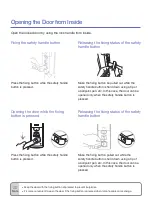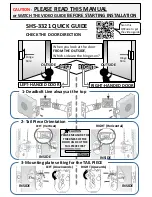
step 4
Take the adaptor kit, item 13
on the contents page. Cut the
two M5 countersunk head
bolts to length to suit the
door thickness; i.e. door
thickness plus a maximum of
10mm (no more than 5mm
should enter the front plate).
Hold the front plate, with a
neoprene seal, against the
door over the protruding
spindle. From the other side
of the door, with the other
neoprene seal in position, fix
the adaptor plate to the front
plate. Before tightening up the
fixings make sure that there is
an equal gap all around
between the plate and the rim
of the neoprene seal to allow
the back plate housing to fit
over the adaptor plate. Do not
use excessive force.
step 5
Be sure that the handle is
fixed to the back plate, and
then remove the plate which
covers the handle spring.
Cut one of the long black
socket head screws to the
required length for your door.
Approximate overall length
should be door thickness plus
25mm, to allow about 10mm
of threaded bolt to enter the
front plate. Use this screw,
with the ‘T’ shaped Allen key,
to fix the back plate to the
front plate through the TOP
holes. Using the 20mm socket
head screw fix the back plate
through the BOTTOM holes to
the adaptor plate. Do not use
excessive force.
step 6
Before closing the door,
enter the code and check
that the latchbolt retracts
when the lever handle is
depressed. Now check the
operation of the inside lever
handle. If there is any binding
of the handles or latch then
loosen the top and bottom
bolts and reposition the plates
slightly until the correct
position is found, and then
re-tighten the bolts.
step 3
Check that the lever handles
are correctly fitted for the
hand of door. To change the
hand of a lever handle, loosen
the grub screw with the small
Allen key, reverse the lever
handle and fully tighten the
grub screw.
MODEL 510/515 INSTALLATION INSTRUCTIONS
The model 510/515 has a tubular, deadlocking, mortice latch and may be used
as a new installation on a door, or where an existing latch is to be replaced.
step 1
Lightly mark a height line on
the edge and both faces of the
door, and on the door jamb, to
indicate the top of the lock
when fitted.
Crease the template along the
dotted line, and tape it to the
door with the top in line with
the height line.
Mark the 2x 12mm and the
1x 20mm holes. Mark the
centre of the door edge on the
Centre Line of Latch. Remove
the template and apply it to
the other side of the door,
aligning it accurately with the
first Centre Line of Latch mark.
Mark the 3 holes again.
step 4
Put the latch into the hole and,
holding it square to the door
edge, draw around the
faceplate. Remove the latch
and score the outline with a
Stanley knife to avoid splitting
when chiselling. Chisel a
rebate to allow the latch to fit
flush to the surface.
step 2
Keeping the drill level and
square to the door, drill a hole
to accept the latch.
step 3
Keeping the drill level and
square to the door, drill the
12mm and 20mm holes from
both sides of the door to
increase accuracy and to avoid
splintering out the door face.
step 5
Fix the latch with the wood
screws, with the bevel
towards the door frame.
step 6
Take the 2-part spindle, with
the springs in place. Note that
one has a RED coloured face,
and the other a BLUE face. If
your door is hinged on the
right, viewed from outside,
then fit the BLUE spindle into
the latch follower on the
outside, with the colour on
TOP. Fit the RED spindle to
the inside, again with the
colour on TOP. For a left hand
hung door fit the spindles the
other way around, with the
colours on TOP.
step 7
Check that the lever handles
are correctly fitted for the
hand of door. To change the
hand of a lever handle, loosen
the grub screw with the small
Allen key, reverse the lever
handle and fully tighten the
grub screw.
























